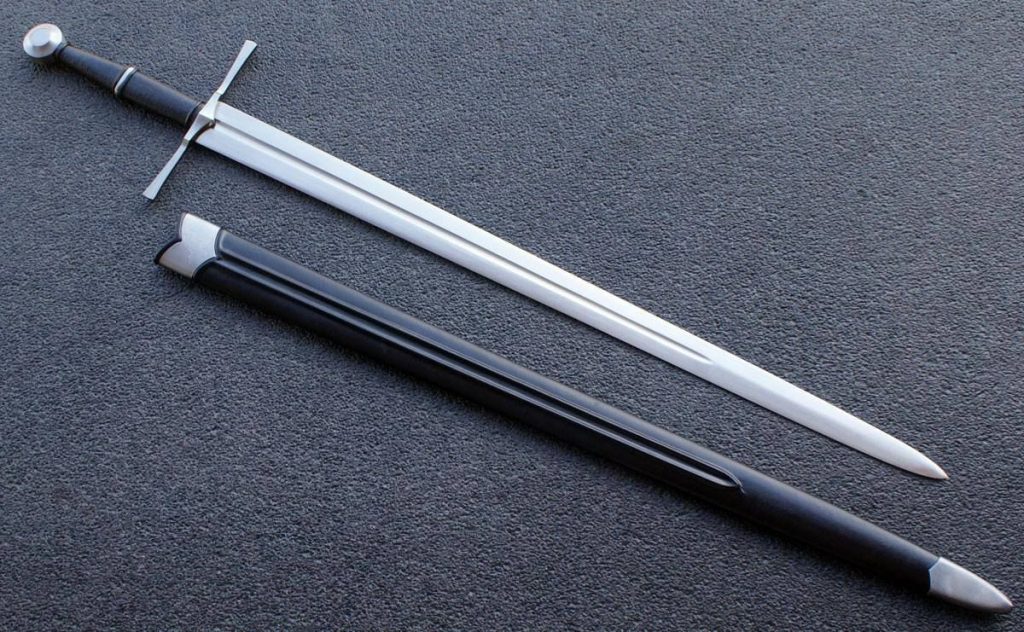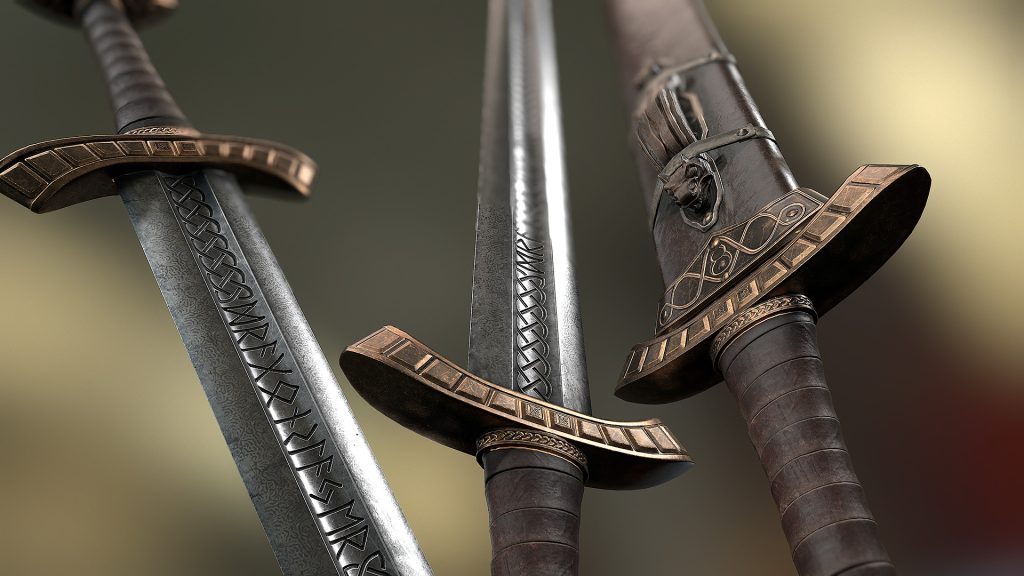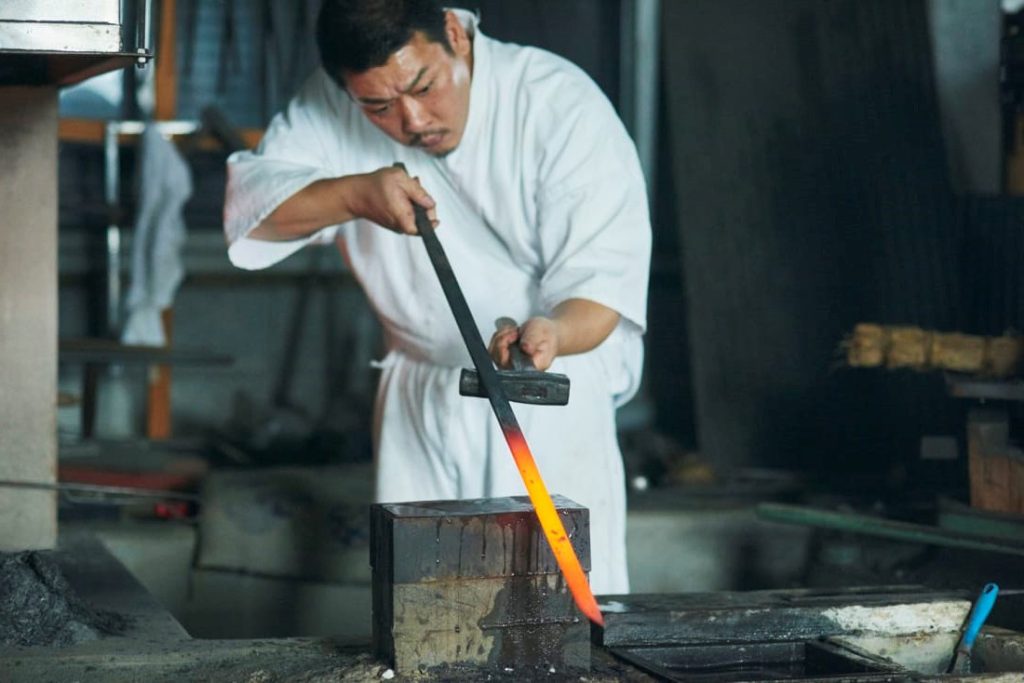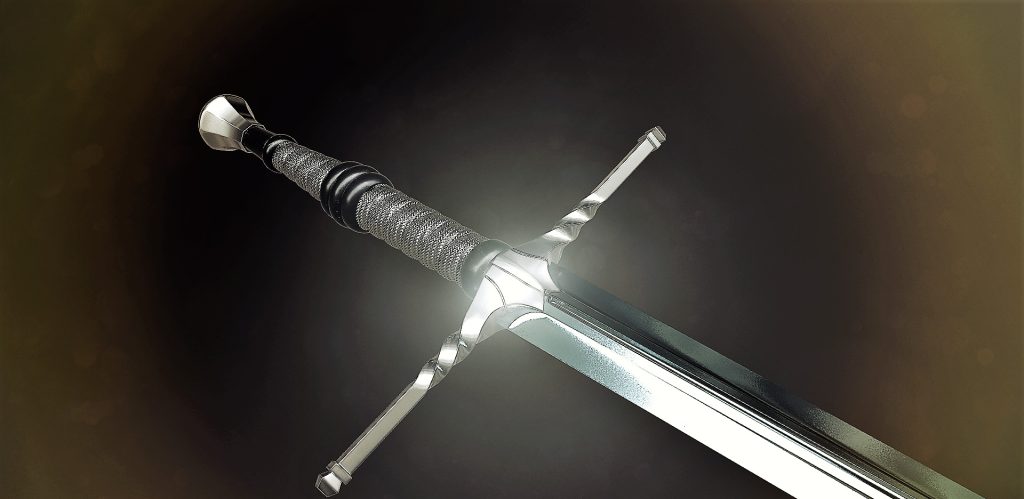Knowing the best material for your sword making, whether you are a fanatical builder or user, is one of the most crucial things. Specifically, you cannot have a decent and functional sword built of poor steel. To give you the best possible response, so you can select whether one to buy or manufacture, this is why I decided to write this article.

By the end of the article, you will have a thorough understanding of each of them, including an analysis of their benefits and drawbacks as well as some useful advice. Let’s begin with the first and most popular steel category, which is steel.
Contents
- 1 So, what is the best steel for a sword?
- 2 High-carbon steel for sword making
- 3 Spring steels for sword-making
- 4 Tool steel for sword-making
- 5 Why is stainless steel bad for swords?
- 6 Is bronze good for sword-making?
- 7 Is Damascus steel really as durable as they claim?
- 8 Frequently asked questions:
- 9 Conclusion
So, what is the best steel for a sword?
The optimum choice for a sword is typically high-carbon steel with 0.6% to 0.7% carbon.
It offers adequate flexibility while maintaining good hardness, which is essential for any blade.
The top 7 steels used to make swords are as follows:
- 1060 medium-carbon steel
- 1075 high-carbon steel
- 1095 high-carbon steel
- 5160 spring steel
- 9260 spring steel
- L-6 bainite
- S-7 shock steel
High-carbon steel for sword making
By far, high-carbon steel is the material of preference when crafting swords. Its carbon content, as its name suggests, makes it perfect for this use.
The American Iron and Steel Institute (AISI) specifies that four digits denote high-carbon steel. It is plain carbon steel, as indicated by the first two figures of 1 and 0. The carbon content is shown in the last two figures. For instance, steel designated as AISI 1095 has a carbon content of 0.95%, while 1045 denotes 0.45%, and so on.
Generally speaking, it is not advised for sword-making steels with less than 0.4% carbon content. Such steel would be too brittle for a sword to be useful. Steel with at least 0.4% carbon is what you need.
Finding the perfect balance between hardness and flexibility is crucial because the harder the blade becomes, the more carbon it contains.
The three steel grades 1045, 1060, and 1095 are the most widely used ones in this group.
Another thing to keep in mind is that, because of the lower level of hardness, the lower the carbon concentration, the easier it is to form. You will understand exactly what I’m talking about if you have ever attempted to forge a tungsten carbine. On the other hand, mild steel is particularly simple to form due to its low carbon content.
Normal definitions of high-carbon steel include those with a carbon content between 0.6% and 1.5%.
They have traditionally been regarded as the greatest options for sword forging due to their high carbon content and other material qualities.
Because of the ease of categorization, I will also add 1045 steel here, even though it isn’t really high-carbon steel.
Therefore, there are three carbon steel grades that are frequently used for swords. These include high-carbon steel 1060, 1075, and 1095.
1060 medium-carbon steel
Even though it has one of the lowest carbon content in this group, this steel is nonetheless widely used to make swords. A great compromise between flexibility and toughness can be found in 1060 steel.
Some sword builders may find that 1045 is too soft and 1095 is too hard. Due to the balance between these two qualities, you could also claim that this fact places it at the sweet spot.
Most katanas are made from this grade of steel since it is also perfect for differential tempering. The visible temper lines on those Japanese swords look fantastic, adding to their visual appeal.

This steel has significantly greater edge retention and is substantially harder than 1045 medium-carbon steel. It also gives a high degree of flexibility, as we’ve already mentioned, which is essential for any sword. You can’t conceive the impact of a mere 0.15% increase in carbon content.
Proper sword maintenance for this steel is particularly crucial because of its weak corrosion resistance.
Swords constructed of 1060 steel fall into the low to medium price range. An item forged from this steel, such as a sword or katana, should cost between $200 and $250. Additionally, 1060 steel is frequently employed by novice sword producers because of its straightforward heat-treating needs.
1075 high-carbon steels
The 1075 high-carbon steel is a fantastic choice as we increase the carbon percentage. As you can see, the carbon concentration has increased by another 0.15%, making this steel a high-carbon steel and harder than before. Additionally, it grips the edges firmly.
Unfortunately, steel becomes less flexible as it becomes harder, making 1075 steel more prone to breaking. Because of this, a good tempering procedure is essential; otherwise, you risk having a not functional sword.
Again, adequate maintenance is essential because of its higher propensity for corrosion due to its high carbon content. Swords constructed of 1075 steel, in my opinion, are incredibly durable.
Due to the straightforward heat-treating procedure, this steel is also quite popular among beginners, much like 1060 steel. In the end, 1075 steel is undoubtedly one of the options to consider if you’re searching for a sword that can withstand a lot of battering.
1095 high-carbon steel
As you are undoubtedly aware, the 0.95% carbon content of 1095 steel is regarded as being rather high carbon. In addition to carbon, it also has a manganese content of 1.2%, which adds to its flexibility and strength. One fascinating fact is that the steel used to make Japanese katanas, 1095, is relatively comparable to that steel (tamahagane).
Steel Katana tools recently have become more popular because of their durability and capacity to maintain a sharp edge.
Be aware that the hardness and strength of the material significantly alter when the carbon content is increased by 0.35 percent from the previous one. Exactly from this car steel, some of my favorite words were fashioned. The Hamon line, which is produced during forging and significantly enhances the sword’s appearance.
When it comes to tempering, 1095 steel is practical for the differential tempering technique, where you make an edge that is harder and a spine that is softer.
The amazing toughness of the 1095 blade gives it many further benefits. One of them is that a sword with a high carbon content may take and keep sharp edges longer than one with a low carbon level. There are drawbacks to steel, just like any other material. Brittleness is one of them, especially because of the high carbon content. It could break if your edge alignment is off.
Heat treatment is essential, just like with any other steel. Even one step of the process gone wrong could result in an unusable blade. You’ll see that heat treating needs to be more cautiously the greater the content.
Low corrosion resistance is another drawback of 1095 steel, but it doesn’t have to be an issue if you clean and oil it frequently. A sword constructed of 1095 steel should cost somewhere between $400 and $450.
Spring steels for sword-making
As the name implies, spring steel is typically used to make shock-absorbing automotive spring bumpers, and it’s also known as a steel alloy. They are a recent advancement in the field of metalworking.

Apart from the fact that spring steel is often tougher than carbon steel, it is also incredibly robust and durable. They are renowned for their capacity to bend after twisting and bending while maintaining their original shape.

The two most common forms of spring steel, 5160 and 9260 steel, are noteworthy. Long swords like katanas, rapiers, and scimitars, these two are typically regarded as the greatest. Remember that spring steel is typically used in the forging of medieval swords.
5160 spring steel
The 5160 spring steel is my all-time favorite steel for a sword if I had to choose just one. It is one of the most widely used steels for forging both large knives and swords. Low-chromium steel 5160 has a chromium content of roughly 0.8%.
Just enough chromium is present at this level to provide good corrosion resistance. In addition to chromium, 5160 steel also contains 0.2% silicon, enhancing its hardness and endurance.
This spring steel has great durability, just like other spring steels. This steel is also used by sword manufacturers like Legacy Arms and Hanwei Forge. That ought to provide you with some insight into the caliber of this fantastic stuff. In some circumstances, a sword of this kind might sever the head of a buffalo in a single blow.
Swords manufactured of 5160 steel are typically mono-tempered, while differential tempering, which results in strong edges, original shape, and a softer center, is an option. The flexibility of 5160 steel is thought to be superior to that of 1095 steel. However, it doesn’t hold edges, as well, as 1095 steel does.
Keep in mind that depending on the intended purpose, high-edge retention can be both good and negative.
9260 spring steel
Cheness Cutlery is responsible for the 9260 spring steel’s notoriety. It has even greater superior durability against extreme bends thanks to the 2% silicon it includes (almost 90 degrees). In addition to silicon, 9260 steel also has manganese, which increases the sword’s toughness. However, we cannot claim that it is more durable if we compare it to tool steel.
More often than not, a sword made of 9260 steel bends more than one made of 5160 steel. Furthermore, 9260 steel is frequently more durable than 5160 steel. If you’re more interested in this comparison, have a look at the 5160 steel here and the 9260 steel here.
With the exception of oxyacetylene torches, practically all other techniques can be used to weld it. In addition to being resistant to corrosion, 9260 steel has a hardness level that can withstand significant cutting.
Note that this sword is not unbreakable despite having good mechanical qualities. Generally speaking, the 9260 sword offers the best value in terms of cost to performance.
Tool steel for sword-making
Recently, I have observed that tool steel is becoming more and more prevalent in the sword industry as I begin to make swords. This type of steel produces highly tough, long-lasting, and edge-retaining swords. The most popular steel for swords is typically tool steel, primarily because of its strength under heavy strain.
In reality, because tool steel is frequently used to create mighty industrial tools that must last for years on end, they are produced with the idea of having significant shock absorption. Imagine what a sword like that could do. Although there are several tool steel grades, L-6 bainite and S-7 shock steel are regarded as the two greatest options for manufacturing swords.
L-6 bainite
Howard Clark began producing this steel in the late 1990s. Low alloy steel is designated by the letter L. As a result of its susceptibility to corrosion, it needs frequent maintenance.
Undoubtedly, one of the toughest sword steel on the market is L-6 when it is properly heat treated. L-6 can be a challenging material to shape during the forging process.
Note that the carbon content of this steel is comparable to that of high-carbon steel 1060 and 1070.
This steel needs to be heated several times to make bainite, which keeps the steel’s high hardness and excellent edge retention. With this brand-new, cutting-edge technology, L6 production is getting a lot simpler.
However, don’t anticipate getting a deal on this. A sword manufactured of L6 bainite is never sold for less than $1000, and its anticipated cost is in the range of $1000 and $1500. Don’t be fooled if you see one for less than the minimum price. Probably some medium-carbon steel is that.
S-7 shock steel
This steel shares several traits with the steel that was previously stated. It can truly take a battering since, as its name implies, it is incredibly shock-resistant. Both hot and cold work services can be performed using S7.
Its carbon and chromium concentration is lower than that of tool steels like A2 and D2. Be aware that S7 swords are quite rare, primarily because they are expensive.
This sword has decent resistance to softening at high temperatures, as well as great shock and impact resistance. S7 has strong heat-treating resistance and can withstand deformation. The ideal range for hardness is typically between 54 and 56 HRC. Even while this steel might be marginally stronger than L6, it still has limitations.
Why is stainless steel bad for swords?
Due to some grades’ extreme toughness and hardness, stainless steel may initially appear to be the perfect material for a sword. Swords, however, are an exception to this rule. In particular, stainless steel is typically not a good material for swords, despite the fact that it can be (and often is) for knives. Here’s why.
Since stainless steel has a stiff structure that limits flexibility and makes the sword brittle, it is typically not a good material for swords. Stainless steel requires a significantly more involved heat-treating procedure, which is another reason why it is not suggested for the construction of swords.
A sword of that nature would also be exceedingly expensive to produce.
I should also add that this technique is made even more difficult by the fact that forging stainless steel is challenging. This steel is challenging to forge into shape, even when it is heated to a red-hot temperature.

This holds true for the stock removal procedure as well. Stainless steel may not be awful for creating blades, but it would take a lot of work to forge a sword out of it, as I have already stated.
Due to the great corrosion resistance of stainless steel, possessing a sword made of it provides the advantage that you won’t need to worry about maintenance as much.
Keep in mind that the majority of what I’ve mentioned so far applies to a functional sword, which is a sword you would actually use. However, by all means, create a wall-hanged sword if you wish to have one.
Is bronze good for sword-making?
As you may already be aware, bronze was a common material for early swords. More specifically, swordsmiths created them by combining copper with different alloys, primarily tin. Swordsmiths didn’t have many options historically because bronze was thought to be the greatest material for a blade.
Bronze is not seen as a suitable material for a sword, particularly in the modern era with so many high-quality steels available. A bronze sword is not strong or resilient enough to be regarded as being of high grade.
The supply of bronze alloys is a challenge as well because there are no copper and tin mines anywhere. The bronze sword’s only advantage would be its resistance to rust and corrosion.
Is Damascus steel really as durable as they claim?
It is, indeed. Damascus steel, in my opinion, was, up to the 20th century, the best material for producing swords historically speaking. It gives the blades a durable body and a cutting edge.
But it can’t yet compete with modern technology. Damascus steel is much more durable than tool steel.
Tamahagane and Damascus aren’t the strongest materials for blades. These swords do, however, have a unique surface pattern. They are costly and unsuitable for daily usage and combat since they have historical value.
Frequently asked questions:
Which metal is best for sword?
For making swords, high-carbon steel is typically regarded as the best material.
Is a titanium sword possible?
Sadly, titanium lacks the strength required to produce a beautiful blade. They have built-in flaws in the titanium architecture and will quickly dull. In addition, if it is forged into a thinner blade, it is quite soft in comparison to steel.
Conclusion
High carbon steel 1060 is the ideal metal for a sword in general. The additional possibilities available to you include 1040 high-carbon steel, 1095 high-carbon steel, spring, and T-10 steel, among others.
It depends on the use you intend for the weapon. As long as you know what you’re searching for, finding the metal online is simple. You can start forging your DIY sword once you have the desired metal.
The two tool steelI would pick if I had to, are L6 bainite tool steel and 5160 spring steel, and they are very strong alloys.


